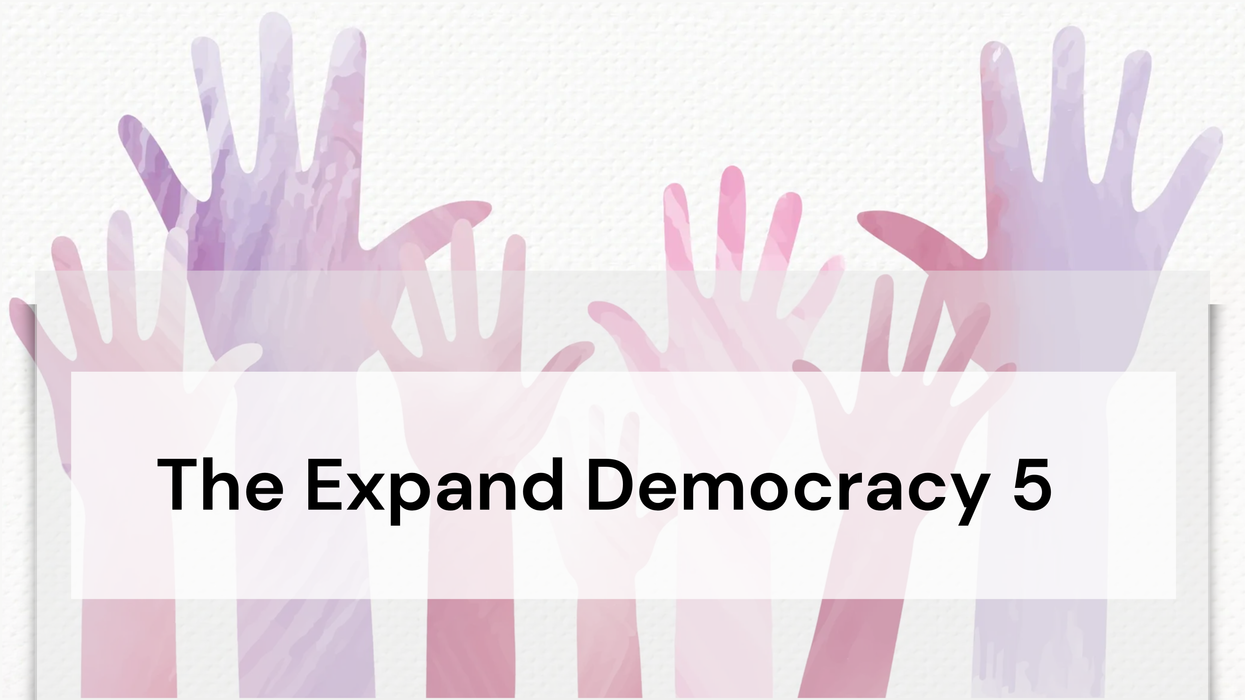The Expand Democracy 5: A Supreme Court out of balance, collaborative legislative rules, a public primary, a faster way to tally ranked choice voting elections, and timely links.
Welcome to the latest edition of The Expand Democracy 5. From Rob Richie, with Eveline Dowling and with Juniper Shelley’s assistance, we highlight timely links and stories about democracy at the local, national, and global levels. Today's stories include:
🔁 Restoring balance to the role of the Supreme Court
💡 Better legislative rules – and learning from the “biscuit tin”
🔓 Consider a “Public Primary” for independent candidates and voters
🧭 A faster, more transparent way to tally ranked choice voting elections
🕓 This week’s (many!) timely links
In keeping with The Fulcrum’s mission to share ideas that help to repair our democracy and make it live and work in our everyday lives, we intend to publish The Expand Democracy 5 in The Fulcrum each Friday.
If you want to suggest a pro-democracy idea for coverage in The Expand Democracy 5, please use the contact form at Expand Democracy.
 Deep Dive - Restoring Balance to the Role of the Supreme Court
Deep Dive - Restoring Balance to the Role of the Supreme Court
[Source: Pew Research Center, August 2024]
Representative democracy in the United States requires a Congress that lives up to its position of primacy in the Constitution. It’s no accident that Article I of the Constitution is about Congress, not the White House and Supreme Court. Among its many powers, Congress is the only federal entity empowered by the Constitution to declare war, appropriate funds, approve treaties, confirm presidential and judicial appointments, and exercise impeachment powers to remove federal officeholders. The decaying role of Congress and its illegitimacy in the eyes of a majority of the American people (with approval ratings consistently below 35% and often far lower) is a fundamental crisis that demands long-term attention and, almost certainly, sweeping reforms to how it is elected and does its business.
With a diminished Congress, what has been a long-standing trend toward presidential power has greatly accelerated, with Donald Trump seeking to wield unheard of powers. Without transparency, he’s imposing and lifting tariffs on incoming goods based on an alleged “emergency” that invites backroom deals and outright corruption. His administration seeks to leverage federal power to override what historically has been the autonomous decision-making of universities, nonprofit organizations, media outlets, law firms, cities, and states. He’s gutting entire agencies already funded by Congress, like USAID and the National Endowment for the Arts. He’s redirecting civil rights enforcement to focus on the alleged mistreatment of white people rather than historically marginalized racial minorities. The list goes on.
Congress has done virtually nothing to push back, with the few Republicans daring to speak out being hounded out of office - with new retirements announced this past week by Nebraska’s Don Bacon in the House and by North Carolina U.S. Senator Thom Tillis the day after Trump called for a primary challenge. Given Congress’s servility, institutional resistance at the federal level has generally come from the judiciary, primarily by district judges who, between January 20th and April 29th, issued at least 25 nationwide injunctions suspending executive actions until further review.
But the Supreme Court gets the final say. This year revealed that it’s hardly a bastion of resistance to Trump’s appropriation of powers. SCOTUS blog’s Amy Howe wrote that “one of the major stories of the term was the unprecedented frequency with which the Trump administration came to the court on the emergency docket – and the success that it generally found there” in overriding these injunctions. The term’s final-day opinion, which removed district judges’ nationwide injunction powers, gave Trump even more authority to bring a wrecking ball to constitutional norms, as blatantly illegal actions may now continue for months even when blocked by district judges. In the Court’s new regime, even an eventual rejection of the executive branch action may mean little. It’s not easy to retrieve people illegally deported to Salvadoran gulags, re-invite international students hounded out of the country, restore jobs to federal workers months after those jobs were abruptly ended, bring back old-growth forest illegally clear-cutted, and so on.
Getting under the hood of the Supreme Court’s ruling reveals a deeper problem: the judicial branch is also out of control. Over the decades, the Court has increasingly amassed greater powers. Its role as the final voice on laws passed by Congress today far oversteps the boundaries that our founders imagined. Consider that in the first 25 years of our nation, Congress passed innumerable game-changing and institution-defining laws without the Supreme Court blocking any of them. Now, nearly every law of note comes before the Court, armed with what amounts to a judicial veto. While today’s Court is deferential to Trump, it may act differently with more liberal presidents.
Amy Coney Barrett wrote the majority opinion in the Trump v. CASA case on nationwide injunctions, but Brett Kavanaugh’s concurrence more clearly defines the Court’s latest power grab. Kavanagh clarifies that courts would continue to have the power to block laws, but only the Supreme Court as “the ultimate decision maker.” Washington Post columnist Jason Willick summarized it well: “Judicial power isn’t being gutted; it’s being centralized.”
That centralization is nothing new. Last year, the Court issued another precedent-changing ruling when it overturned the Court’s 1984 decision that established the Chevron doctrine. Under that doctrine, when an act of Congress was unclear, judges had to be deferential to federal agencies’ statutory interpretations of it unless clearly unreasonable, recognizing that agencies would have more expertise than judges on such matters. But now that power instead rests solely with the federal courts - and of course, ultimately the Supreme Court.
Beyond the power grab, the uncomfortable reality is that the Court’s divided decision-making process is most predictable based on the party of the president who appointed the justices. The Court’s six Republican appointees make up a conservative majority that generally isolates the Democratic appointees on divided cases, further undermining the Court’s legitimacy as a nonpartisan actor. Since 1992, Democrats have won the popular vote in presidential elections seven times and the Republicans only twice, but Republicans have a solid 6-3 majority on the Court that could endure for decades to come.
It’s time to consider checks on the Supreme Court short of the herculean task of amending the Constitution. Doing so would be healthy for the Court as well, as its legitimacy will continue to decline if it operates like a court branch of government that is largely immune to the people. Since 1992, Pew finds that the Court’s favorability has fallen nearly in half from 80%, and the gap in views of the Court by party affiliation is historically wide, trends also confirmed by Gallup.
We know what reform might look like. Joanna Lampe of the Congressional Research Service in 2023 wrote a thorough analysis of a wide range of potential changes, while Joe Biden’s Presidential Commission on the Supreme Court issued a comprehensive review of ideas in 2021. One simple change is grounded in the fact that the number of justices is established by statute, with nine not being a consistent number. Replacing lifetime tenure with 18-year terms makes great sense in the modern era, given how average lifespans have soared since 1787; they could also face a retention election after nine years. In the spirit of checks and balances, a supermajority of Congress could override a Court rejection of a federal statute. Short of such major actions, there’s a menu of ways for Congress to pass statutes to hold the Court to ethical and workplace standards typical of other federal branches.
I don’t profess to have the answers, but it’s time to ask the question, especially as today, July 4th, we celebrate government by “the consent of the governed.”
 Collaborative Policymaking – and Learning from the “Biscuit Tin”
Collaborative Policymaking – and Learning from the “Biscuit Tin”
[Jacinda Ardern’s final speech in the New Zealand parliament, home of the “biscuit tin.” Source: New York Times]
This week marks an utter failure in collaborative policymaking in Congress, with Republicans jamming through legislation sought by Donald Trump that will raise the debt ceiling by more than $5 trillion while enacting a series of Republican-only wish list items. And, to be sure, Democrats have had their share of one-party votes as well in recent decades when in power.
In 2015, FairVote and the Bipartisan Policy Center collaborated on an important project, resulting in a joint report on Best Practices for Collaborative Policymaking: Learning from Power-Sharing Arrangements in State Legislatures, with lead author Andrew Douglas. While centered on what legislative chambers do when exact ties in a chamber require rules for working together, it also highlights the value of some states’ ongoing practices. One section has this lead:
“As the centralization of agenda-setting power in the hands of majority party leadership represents the greatest procedural obstacle for the creation of bipartisan legislation, the enactment of rules that do away with these privileges altogether is the single most effective action a legislature can take to promote bipartisan policymaking. Far from a post-partisan pipe dream, rules that achieve this end at the committee or calendar stages of the legislative process are in effect in many state chambers, where they have had a demonstrable impact on the prospects for bipartisan policymaking.”
Examples of best practices in states include requiring committees to hear all bills and automatic calendaring of more legislation for floor votes (with Nebraska allowing each legislator this power on their priority bills), along with more nuanced changes.
New Zealand has a particularly charming, yet empowering example, nicknamed “The Biscuit Tin.” I learned about the Biscuit Tin from a new book by former New Zealand prime minister Jacinda Ardern called A Different Kind of Power, about her political history and recommendations for leaders. Here’s more on “the Biscuit Tin” from the Associated Press:
“The ceremonial lottery at Parliament, where bills are drawn randomly from what’s known as ‘he biscuit tin’ in local parlance, is a way to ensure every New Zealand legislator has the chance to advance a proposed law, no matter how unpopular their bid…The lottery has produced some of New Zealand’s most notable modern laws. Bills legalizing marriage equality and voluntary euthanasia were once drawn from the cookie tin and eventually enacted after their sponsors launched sweeping public campaigns to sway the opinions of their peers.
“Most laws that pass through New Zealand’s Parliament need never enter the ballot. They’re part of the government’s legislative agenda, advanced by senior legislators from ruling parties who already know their proposals will succeed by vote. But on one day each fortnight that Parliament sits, bills drawn from the cookie tin are debated….”
The best time to change chamber rules is when there is a rare opening for a new Senate president or speaker. Please ask your state legislators and Members of Congress to be ready to demand better rules before giving a prospective leader their vote!
 Consider a “Public Primary” for Independent Candidates and Voters
Consider a “Public Primary” for Independent Candidates and Voters
With more Americans every day registering to vote outside the major parties - now nearly a third of all registered voters nationwide - more states with closed primaries are exploring solutions to ensure primary electorates don’t keep shrinking. One obvious reform solution is to do what New Mexico passed this year - a semi-open primary where unaffiliated voters are allowed to vote in a party primary.
Chad Peace of the Independent Voters Network has long suggested an alternative: creation of a “public primary” that could be structured in different ways. One approach would be to have an additional primary that could be contested by any candidate and allow votes from any voter, including candidates and voters also voting in a partisan primary. Another approach would be to limit participation in this public primary to candidates and voters who don’t participate in a partisan primary - and only advance the winner to the November ballot. Either way, a public primary would give more visibility across the year to independent candidates, and could be a vehicle for a candidate to have a means to get to the general election ballot\ even when losing a major party primary.
Here is an excerpt from my 2016 FairVote blogpost on the proposal, where I detail ways such a Public Primary could strengthen democracy:
- Every voter could vote in a primary contest, unlike the status quo, in which a growing number of Americans are excluded from closed primaries due to their choice of party affiliation.
- Parties would maintain their freedom of association, and no candidate currently securing a place on the November ballot would be denied that opportunity.
- The general election ballot would usually have a significant number of additional candidates for voters to consider in November, when turnout is higher and more representative.
- Ranked choice voting would avoid split votes and “spoiled elections” for all races with more than two candidates, giving voters greater freedom to consider their favorite candidates and encouraging candidates to reach out beyond their base.”
With 2026 likely to result in a big uptick in serious independent candidates for office, conversations about a Public Primary are all the more timely.
 A faster, more transparent way to tally ranked choice voting elections
A faster, more transparent way to tally ranked choice voting elections
[Source: New York Times]
New York City held a remarkable ranked choice voting primary this year. RepresentWomen reports that women again look to win 31 of 51 city council seats, up from just 13 before the first RCV primaries in 2021. In the Democratic mayoral primary, RCV created a more positive electoral atmosphere, embracing the City' s pluralism that looks to result in winner Zohran Mamdani winning more votes than any nominee in City history, grounded in a surge in voter turnout by younger voters that cuts against all trends. The New York Times reported on the role of RCV in a post-primary piece called New Yorkers Embraced Ranked-Choice Voting, including:
“The campaigns tried to educate voters about the new voting system, and it appears to have worked. Roughly 95 percent of voters ranked either Mr. Mamdani or Mr. Cuomo on their ballots, allowing them to survive until the final round. Most voters said they understood the system and wanted to keep it, according to an exit poll from SurveyUSA that was paid for by groups that support ranked-choice voting, including Common Cause New York and FairVote
‘We’ve always said that we needed to get through two mayoral primaries to really see how ranked-choice voting was going to work,’ said Susan Lerner, the executive director of Common Cause New York. ‘Candidates really embraced ranked choice voting this go-around and I think that’s just an indication that the system is maturing in New York City.’
Roughly three-fourths of voters said they wanted to keep or expand ranked-choice voting, and about 17 percent said it should not be used for municipal elections.”
But there was one frustrating downside. Unlike the 79% of jurisdictions that report their first RCV tallies within 24 hours of polls closing, New York City waited a week, and the City's Board of Elections won’t release the underlying day for weeks to come. While the mayoral outcome was clear, former frontrunner Andrew Cuomo had to decide before the first RCV tally was released whether to stay on the ballot for November. He chose to do so, yet the RCV tally later showed his losing margin growing from 7% to fully 12% after the instant runoff.
The Expand Democracy team has been working with Brian Strege on a better approach. A committed volunteer working with Grow Democracy DC to implement Washington, D.C.’s big ballot measure win for RCV in 2024, Brian has software skills and insights that promise to be a game changer for establishing a new approach that emphasizes transparency, speed, and auditability. It is grounded in having a "precinct-summable tabulation" that would simplify what local election officials are asked to do: to generate and upload sums of each ranking permutation, ideally at the same pace as non-RCV results. That would allow election officials to run the RCV tally as frequently as they chose, and allow the public to do their own tallies and analysis.
Expand Democracy is going over this proposal carefully with a group of former election officials that has volunteered to offer advice on the potential impact of reform ideas on election administration. We plan to work with partner groups and election officials to pilot this new format in cities using RCV, ideally as soon as November.
 Timely Links
Timely Links
We close The Expand Democracy 5 with notable links:
- “US state department told to end nearly all its overseas pro-democracy programs”: From the Guardian: “The US state department has been advised to terminate grants to nearly all remaining programs awarded under the Bureau of Democracy, Human Rights, and Labor (DRL), which would effectively end the department’s role in funding pro-democracy programming in some of the world’s most hostile totalitarian nations. The review could affect nearly $1.3bn in grants… Of 391 active grants, only two were not recommended to be cut.”
- “Some good news about political polarization: It can change”: From Politico: “Voters in one of the most divided states in the country moved closer together on immigration, climate change and voter ID requirements after spending just a few days together. A diverse set of nearly 200 Pennsylvanians from the state’s big cities, far-flung towns and upscale suburbs found common ground on those and a number of other hot-button topics after meeting in a hotel in downtown Philadelphia last month as part of an audacious experiment: If people got offline and actually talked face-to-face, would they become less polarized? Political scientist James Fishkin, who leads Stanford University’s Deliberative Democracy Lab, has tested that theory across the globe, and each time the answer has been yes.”
- “By the People: Expanding Citizen-Led Policy in the United States”: From the introduction of a new report by New America: “Expanding Citizen-Led Policy in the United States,” a project of New America’s Political Reform program, explores the uneven landscape of citizen-led policymaking in the United States, the feasibility and advantages of expanding ballot initiative processes to more states, and possible strategic paths reformers might take toward that goal.While 26 states provide for at least one form of statewide citizen-initiated ballot measure, the rest of the country, home to about half of all U.S. residents, lacks any initiative access at the state level. This collection features resources, reports, and articles on expanding the number of U.S. states that allow ballot initiatives.
- “Election Administration and Voting Survey Comprehensive Report”: From the federal Election Assistance Commission: “On June 30, 2025, the EAC published the biennial Election Administration and Voting Survey (EAVS) Comprehensive Report, an analysis of state-by-state data that covers various topics related to the administration of federal elections. Topics covered through EAVS data collection relate to voter registration and list maintenance, voting practices for overseas citizens and members of the armed forces serving away from home and other important issues related to voting and election administration. It is a survey of all 50 U.S. states, the District of Columbia, American Samoa, Guam, Northern Mariana Islands, Puerto Rico, and the U.S. Virgin Islands.”
- “Why it’s better to doubt than to know”: The Washington Post published an oped by fellow philosophy major Clary Doyle from her commencement speech this year at Northwestern: “While the world we live in is frightening, my wish is that we embrace this aspect of our education and continue to ask questions. Graduation speeches usually end with a call to change the world, but the truth is, the world will change whether you do anything about it or not. So instead, I encourage you to do something much harder, something more important, and that is to change your minds.”
- “ Remembering acclaimed public TV journalist Bill Moyers”: A toast to one of the truly remarkable people of our time, who died this week, From the PBC News Hour: “Bill Moyers, a legend in the world of journalism and a longtime member of the extended PBS family, died Thursday at the age of 91. Moyers was perhaps best known for his long-running programs and documentaries he produced at PBS. Some of those programs included the weekly "Bill Moyers Journal," and documentary series, including "Joseph Campbell and the Power of Myth," which drew 30 million viewers.” Eric Alterman also wrote about his impact in the New Republic.




















